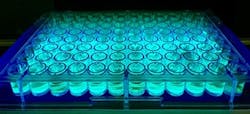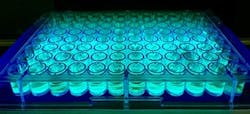Reaction Research Gets A Boost
A novel screening process removes the role of chance in discovering new catalysts and their associated reactions, report chemists at the Institute of Organic Chemistry at Münster University, Münster, Germany. Their two-step process can identify previously unknown interactions between catalysts and molecules, say the researchers.
The first step examines whether a potential substrate interacts at all with a catalyst. In the case of photocatalysts (Figure 1), which the team found particularly well suited to the new technique, emission quenching detects such interactions. However, these interactions don’t constitute reactions. So, the second step looks for the presence of reactions when a reaction partner and a catalyst are present. Combining the two screening steps enables identification of both partners in a new reaction.
Figure 1. This evaluation looks at impact of a photocatalyst on a variety of possible substrates. Source: Felix Strieth-Kalthoff.
“This two-dimensional strategy enables us not only to find new catalyst/substrate interactions but also to actually discover new reactions — including some we hadn’t previously expected,” explains Frank Glorius, a professor of organic chemistry at the Institute.
So far, the chemists have discovered and further developed three previously unknown reactions, including a photochemical cycloaddition that transfers simple, flat molecules called benzothiophenes to complex three-dimensional structures. From an energetic point of view, that reaction shouldn’t be possible, they note.
Photochemical process expert Dirk Guldi at the University of Erlangen, Erlangen, Germany, and colleagues from the Leibniz Institute of Surface Engineering, Leipzig, Germany, carry out the detailed analysis of the reactions. They use ultrafast spectroscopy to observe and investigate the individual steps in a reaction, including the key activation step.
“This greater understanding will allow the development of new processes and catalysts,” stresses Guldi.
“The transformations reported in our study — and further analyzed and learnt about by using high-end mechanistic tools — were based on energy transfer utilizing visible light. Based on more powerful catalysts and improved mechanistic understanding, we are currently trying to develop more visible-light-mediated reactions of this kind,” comments Glorius. “The field is developing rapidly and many reactions are waiting to be discovered, or developed,” he adds.
The team is enthusiastic about developing smart screening strategies and already has exciting unpublished results, says Glorius. “In addition, recently we have also started to use machine learning methods to analyze the data the screening provides.”
Making the screens very focused could enable their use for solving specific industrial problems, he feels.

